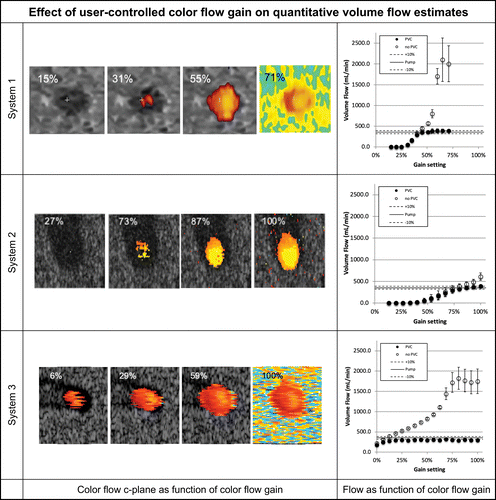3D Ultrasound Yield Accurate Volumetric Blood Flow Measurements Non-Invasively
Monitoring color flow gain in 3D quantitative blood flow measurements provides accurate and reliable information.
Estimating blood flow across a variety of systems and facilities with a 3D ultrasound approach is both effective and non-invasive, according to newly published research.
Being able to accurately and quickly assess blood flow measurements and blood flow to organs, such as the heart and brain, is critical in emergency situations. These measurements also play a role in chronic disease management, such as monitoring blood flow to the hands and feet in patients with diabetes. But, getting reliable measurements is difficult.
“Right now, we just don’t have anything better to quantify blood flow,” said Oliver D. Kripfgans, Ph.D., associate professor of radiology at Michigan Medicine and lead study author of the article published in Radiology.
Current tactics, including blood pressure measurements and 2D ultrasound, such as spectral Doppler, provide surrogate measures rather than actual volumetric flow. They are also error prone and can vary significantly between facilities and operators.
Volume flow as a function of color flow gain (at a single testing site). For each row the color flow c-plane and the computed volume flow are shown as a function of color flow gain. The c-plane is shown for four representative gain levels, whereas the computed volume flow is shown for 12–17 steps across the available gain settings. Flow was computed with (solid circles on the graphs) and without (hollow circles on the graphs) partial volume correction. Partial volume correction accounts for pixels that are only partially inside the lumen. Therefore, high gain (ie, blooming) does not result in overestimation of flow. Systems 1 and 2 converge to true flow after the lumen is filled with color pixel. System 3 is nearly constant regarding gain and underestimates the flow by approximately 17%. Shown are mean flow estimated from 20 volumes, and the error bars show standard deviation. Courtesy: Radiology

To fix this problem, Kripfgans’ team has spent several years developing a 3D approach that could yield quantitative measurements. For this study, the team partnered with volunteers from the Quantitative Imaging Biomarkers Alliance (QIBA), a healthcare research alliance launched by the Radiological Society of North America to improve current biomarkers and investigate new ones.
Together, the group tested their 3D strategy on three clinical scanners using a custom flow phantom, a device that mimics human blood flow. In seven different labs, they altered eight distinct testing conditions, including changing flow rate, imaging depth, and other parameters, to evaluate the approach’s efficacy and reliability. For each scanner, they monitored and recorded 3D quantitative blood flow measurement dependence on color gain. This tactic, the team said, decreased user and scanner measurement variability.
According to Kripfgans, their analysis revealed that blood flow volume that is estimated by 3D color-flow ultrasound is accurate. The findings, he said, were reproduced across all seven labs.
“We had less than 10-percent error or variation,” he explained. “For some of the systems, we were down to only 3-percent to 5-percent difference between labs. These are fantastic results that show that, from a technology point-of-view, some systems could be ready to go to the clinic.”
Because the system is easy to use, it reduces the variation between operators and facilities that routinely pop up with existing blood flow assessment tactics, he said. The range of tested flows means that the 3D approach could have a wide range of clinical applications, including peripheral vascular flow and cerebral blood flow estimation other than perfusion and cardiac output. And, blood flow estimation could allow for:
- More accurate measurements in hemodialysis arteriovenous fistulas and grafts
- Evaluating stenosis and function in transjugular intrahepatic portosystemic shunts
- Potential umbilical cord blood flow
Alongside these possible clinical applications, having QIBA involved, with its goal of accelerating the development and adoption of hardware and software standards to facilitate accurate and reproducible quantitative imaging method results, will make implementation of the 3D approach in patient care much easier, he said.
“Because of QIBA and this study, I’m confident that this 3D ultrasound technology is on a path to the clinic,” Kripfgans said.
The Reading Room: Racial and Ethnic Minorities, Cancer Screenings, and COVID-19
November 3rd 2020In this podcast episode, Dr. Shalom Kalnicki, from Montefiore and Albert Einstein College of Medicine, discusses the disparities minority patients face with cancer screenings and what can be done to increase access during the pandemic.
What New Research Reveals About Novice Use of AI-Guided Cardiac Ultrasound
April 4th 2025In a study recently presented at the American College of Cardiology (ACC) conference, researchers found that novice use of AI-guided cardiac ultrasound after an AI-enabled electrocardiogram increased the positive predictive value for reduced left ventricular ejection fraction (LVEF) or aortic valve stenosis by 33 percent.
New AI-Enabled Portable Ultrasound May Facilitate 50 Percent Reduction in Cardiac Imaging Scan Time
March 28th 2025Artificial intelligence (AI)-powered measurement capabilities provide key features with the Compact Ultrasound 5500CV device, which was unveiled at the American College of Cardiology (ACC) conference.